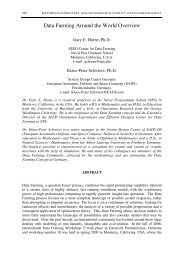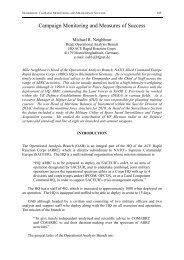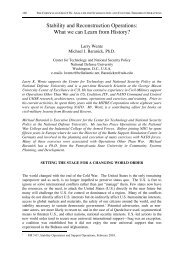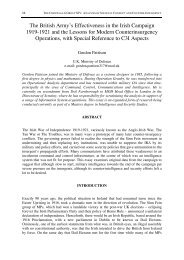Modeling Stability and Reconstruction Operation ... - Cornwallis Group
Modeling Stability and Reconstruction Operation ... - Cornwallis Group
Modeling Stability and Reconstruction Operation ... - Cornwallis Group
Create successful ePaper yourself
Turn your PDF publications into a flip-book with our unique Google optimized e-Paper software.
236 THE CORNWALLIS GROUP XI: ANALYSIS FOR CIVIL-MILITARY TRANSITIONSthat the number of new visits per person per year is 3.0 – 5.0. Using the same assumptionsabout follow-up visits, we have approximately 6.375 – 10.625 visits per year.As shown in Figure 4, we start by rough estimation of the parameters of the sicknessmodel. These are linear approximation from the empirical data. We run the models <strong>and</strong>analyze the results. Next we introduce non-linearity to better match the historical time seriesdata which provides better estimates. These steps assume that the size of the camp isconstant. In the following phase of calibration we relax this assumption <strong>and</strong> allow newrefugees/IDP to enter the camp. In the final step of calibration, we introduce sickness rates<strong>and</strong> medical facilities distribution <strong>and</strong> readjust the parameters to match the empirical data.INTERVENTION CALIBRATIONIntervention calibration entails adjusting the responsiveness of the model taking into accountthe ranges of values for each relevant variable. Some of the variables may have directimpact on the observed metric while the other may have indirect impact. For example, whilesanitation may be assumed to have a direct impact on number of sick, closure of supply routemay have indirect impact. As shown in Figure 5, we perturb the PmESII values to get thedistributions for sickness <strong>and</strong> wellness.Figure 5: Intervention Calibration Process.










